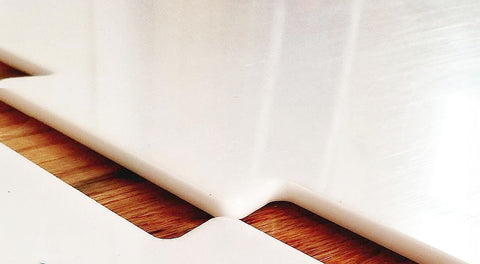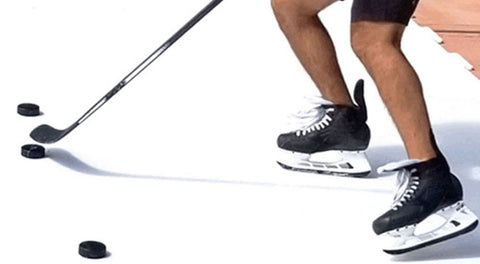Are Hockey Tiles Great For Training? How To Up Your Game On The Ice
At the highest levels of sport, what you see on the court, field, or ice is not a sudden explosion of innate talent.
It culminates hours, days, months, and years of training.
Bryant. Brady. Woods. Gretzky.
Some of the greatest athletes in the world are/were relentless trainers.
The same goes for ice hockey.
Consistent training and the honing of specific skills cannot be understated.
However, frequent visits to commercial hockey rinks can be both time-consuming and expensive.
CHECK OUT THE ORIGINAL HOME HOCKEY TILE BY POLYGLIDE SYNTHETIC ICE
You need both on-ice and off-ice training.
Thanks to the creation and growing popularity of hockey tiles, you can now train at your gym, outdoors, or in the comfort of your home.
But are these hockey tiles great for training?
We'll explore what you need to know about hockey training tiles available and how they can elevate your training experience.

Understanding Hockey Tiles
Let's face it: some surfaces are better for some activities than others.
You can't roller skate on the sand.
And you can't play ice hockey without ice.
That is, until now.
Hockey tiles are synthetic ice tiles that mimic the look and feel of ice.
Multiple types are available, but the best are made of a solid polyethylene polymer that is infused with a slip agent to give you that smooth surface needed for skating and puck movement.
Just one large tile allows players to practice various skills, including stickhandling, shooting, and passing.
The tiles usually have dovetail edges, allowing you to connect them to create a large surface in the shape of your choice.
Connect multiple tiles over a large surface, like your backyard, and you can play an actual game with multiple players for training or fun.
Hockey tiles like synthetic ice have been around for decades, mainly in commercial spaces.
Thanks to design improvements and reduced raw material costs, almost anyone can buy and set up a synthetic ice rink.

Benefits of Hockey Tiles
So why are hockey tiles great for training?
First of all, you can put in many more training hours, especially on specific skills.
Access to a rink can be challenging, especially for players with limited access to resources.
Investing in one or more hockey tiles means you won't have to depend on renting or driving to a rink.
You can use your stick and puck, which provides a more realistic training experience.
Unless you live in a state where it snows, ice rinks are also primarily indoors.
Hockey tiles can be used indoors, outdoors, and at any time of year, giving you more versatility in your training.
That also means you can train in the summer or the off-season when your competitors take time off.
These tiles are also sturdy, with synthetic ice being the most durable.
Most hockey ice tiles can last ten or more years, with minimal damage from your ice skates.
The best synthetic ice tiles come with a solid core, allowing you to turn them over to use both sides to maximize their lifespan.
Clean off the shavings produced by metal skates, and you have a fresh tile that performs better with more use.

Hockey Tiles and Training
Hockey tiles are convenient, versatile, and long-lasting, but how useful are they for training?
Using hockey tiles is one of the best ways to improve your puck-handling skills while skating.
The surface mimics the glide of natural ice, so your puck will respond as expected.
Hockey tiles can help you achieve soft hands, improve forehand/backhand transitions, puck agility, and more.
Today's fastest NHL players are agile and change direction with ease. Some even go beyond 24 mph in bursts on the ice.
Train with hockey tiles to get faster and improve your agility and skating power.
You can level up your edge work using drills focusing on proper weight transfer or set up cones to improve your agility.
Synthetic ice tiles also help with your skating power.
The tiles have slightly more friction than natural ice.
That extra bite translates to more power and, ultimately, more speed on the ice.
Finally, it's a great tool to improve shooting power and accuracy.
Set up a few tiles, a net, and a rebounder bounce bar to get in more shots over a shorter timeframe.
Practice wrist shots, slap shots, and shooting from range.

Some Things to Consider
While hockey tiles are fantastic training and recreational tools, some downsides exist.
- It has a coefficient of friction: Synthetic ice tiles produce more friction against metal blades than natural ice. Even with a slip surface agent applied, hockey players notice the difference. The goal is to invest in an infused hockey tile designed to limit friction.
- Upfront costs: You can grab some off Amazon, but they will likely be useless in a year. High-quality hockey tiles are an upfront investment to build a backyard rink. However, these tiles can last over ten years, meaning it's a minimal investment when extrapolated over that timeframe.
- Noise levels: Some hockey tiles can be noisy, especially when used for shooting drills. This is fine if you're outside but may be a concern if you live in an apartment or have noise restrictions. Get tiles that can absorb more energy, making them quieter.
These downsides are minimal as the performance gains you achieve over time are well worth it.
Conclusion
High-quality hockey training tiles are a game-changer for any aspiring hockey player.
If you have limited access to an ice rink and want to improve specific skills, it's an excellent investment.
You can spend hours on shooting, stick handling, accuracy, speed, and more.
It's also a fantastic way to build a private rink for games with family, friends, and teammates.
Not sure which one to choose?
PolyGlide Synthetic Ice comes in Home Ice Tiles, great for small spaces and simple hockey drills, or the thicker Pro Glide Panels for longer, more advanced training and gameplay.
Contact us today and we can help you find the perfect synthetic ice for your space and training needs.
With the right set of tiles, you can elevate your game and take your hockey performance to the next level.




